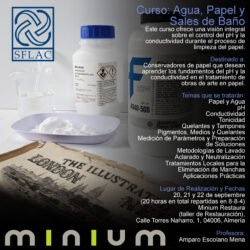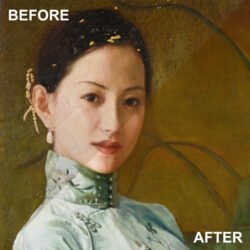Deacidification, neutralization, and alkaline reserve may sound like chemistry terms, but they're actually the trio that paper conservators rely on to save the day because preserving the past for the future isn't just about nostalgia - it's about protecting our cultural heritage with the power of science and conservation.
Deacidification is the process of removing the acids that may be present in the paper. Over time, paper can become acidic due to the breakdown of cellulose and the presence of acids in the environment, becoming brittle, and discolored, and in extreme cases can eventually disintegrate. The most common method of deacidification is through the use of a cleaning solution to remove the acids from the paper.
Neutralization is a related process that involves adjusting the pH of paper to a neutral level (around pH 7).
Alkaline reserve refers to the buffering capacity of paper to resist further acidification. During conservation treatments, conservators aim to increase the alkaline reserve of paper, by applying an appropriate solution.
The drawing below, ink on Japanese paper by the French artist Eugene Berman, is a great example to explain these three concepts. With aging, the support has become acidic and yellowish. At some point, by accident, it got partially wet, and the degradation products already present on the paper because of the acidification were displaced creating the tide line on the bottom left corner.
During the conservation process, the acids from the paper were removed, it was therefore deacidified. By using buffered solutions, the paper was neutralized to a suitable pH. We controlled the conductivity level at the beginning of the process and maintained it after the process with a final bath loaded with calcium ions. This replenished the void left by the removal of degradation products with calcium, creating an alkaline reserve.
While we can't show that we achieved a neutral state or added an alkaline reserve, the picture below illustrates how an alkaline reserve can prevent yellowing in materials.
The drawing above was made using Indian ink on Japanese paper. Indian ink is a waterproof, black drawing ink typically made from carbon black or lamp black. It is mixed with shellac as a binder and is commonly soluble in alcohol. The ink may also contain an emulsifier, borax, which has a pH of around 9.1 and gives some alkalinity to it. This appears to be the case in this drawing, as the areas of the paper where the ink was applied had a certain alkaline reserve.
The paper was in contact with a low-quality backing board that became acidic over time. However, in the areas where the ink was thicker, the alkalinity of the ink prevented the yellowing of the corresponding part of the backing board. Thus, the ink acted as an alkaline reserve for both the paper and the backing board, and on the backing board, due to the zonal differences in acidity, a negative image of the original drawing was created.
Overall, deacidification, neutralization, and alkaline reserve are all important in paper conservation; they can help to preserve paper documents and artworks for future generations. By creating a stable, pH-neutral environment and counteracting the effects of acidic compounds, conservation professionals can ensure that these works of art, documents, etc., are available for study and enjoyment for many years to come.





